Change Resistance: Affects Implementation of Change - Essay
VerifiedAdded on 2022/12/15
|6
|1626
|321
Essay
AI Summary
This essay delves into the critical issue of resistance to change and its profound impact on the successful implementation of planned organizational changes. It highlights the multifaceted reasons behind resistance, including emotional attachments, trust issues, cultural dissimilarities, and unmet expectations, particularly within the context of mergers. The essay explores the roles of transactional and transformational leadership, emphasizing employee involvement and the application of complexity theory to navigate the complexities of change. It examines the limitations of models such as Lewin's and Kotter's, discussing their strengths and weaknesses in addressing the nuances of change management. The essay further underscores the influence of technology, employee participation, and organizational behavior on the change process, along with the importance of establishing a clear vision and allocating resources effectively. The essay concludes by emphasizing the need for organizations to proactively address resistance, foster teamwork, and implement strategies to ensure the effective execution of change initiatives.
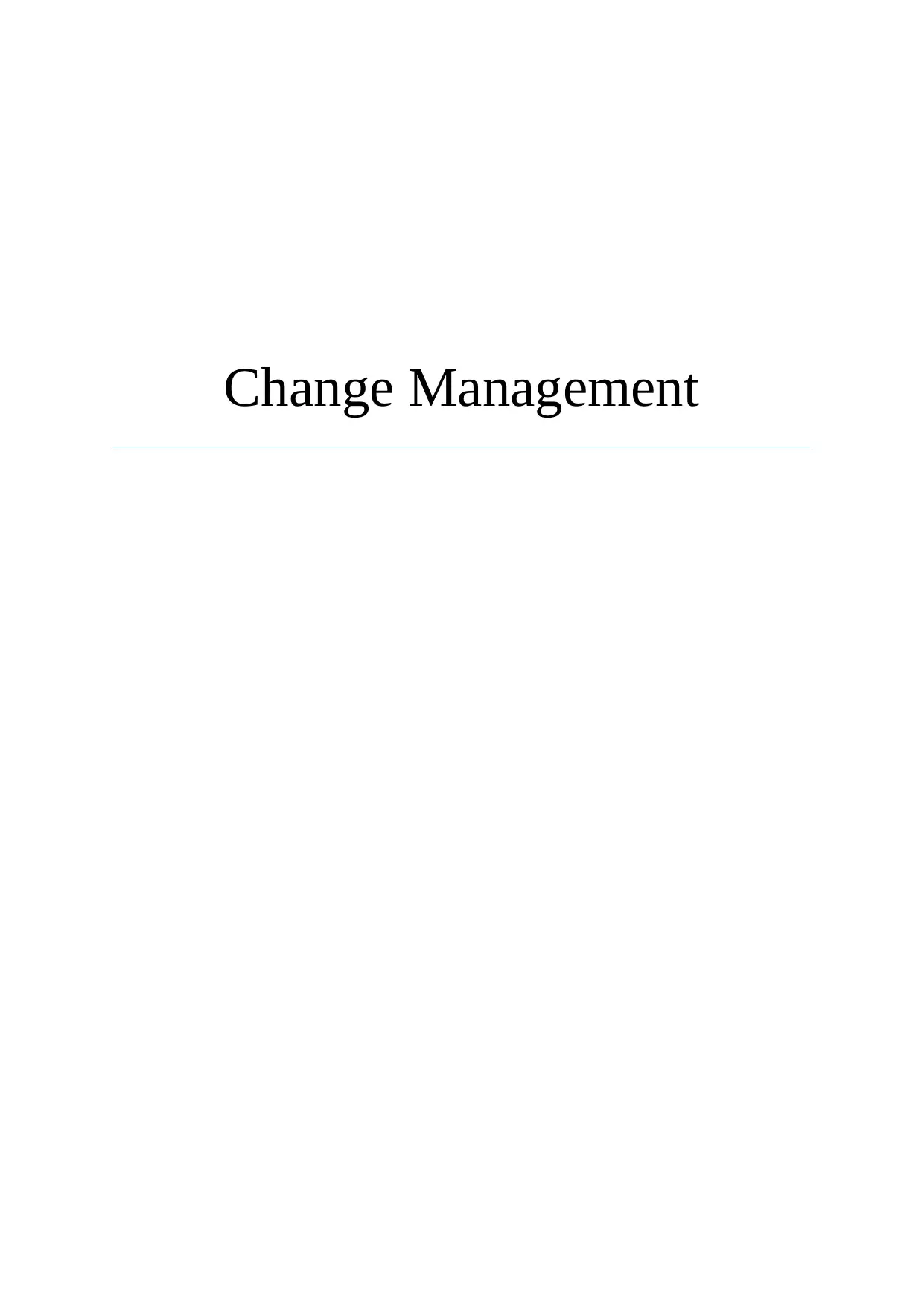
Change Management
Paraphrase This Document
Need a fresh take? Get an instant paraphrase of this document with our AI Paraphraser
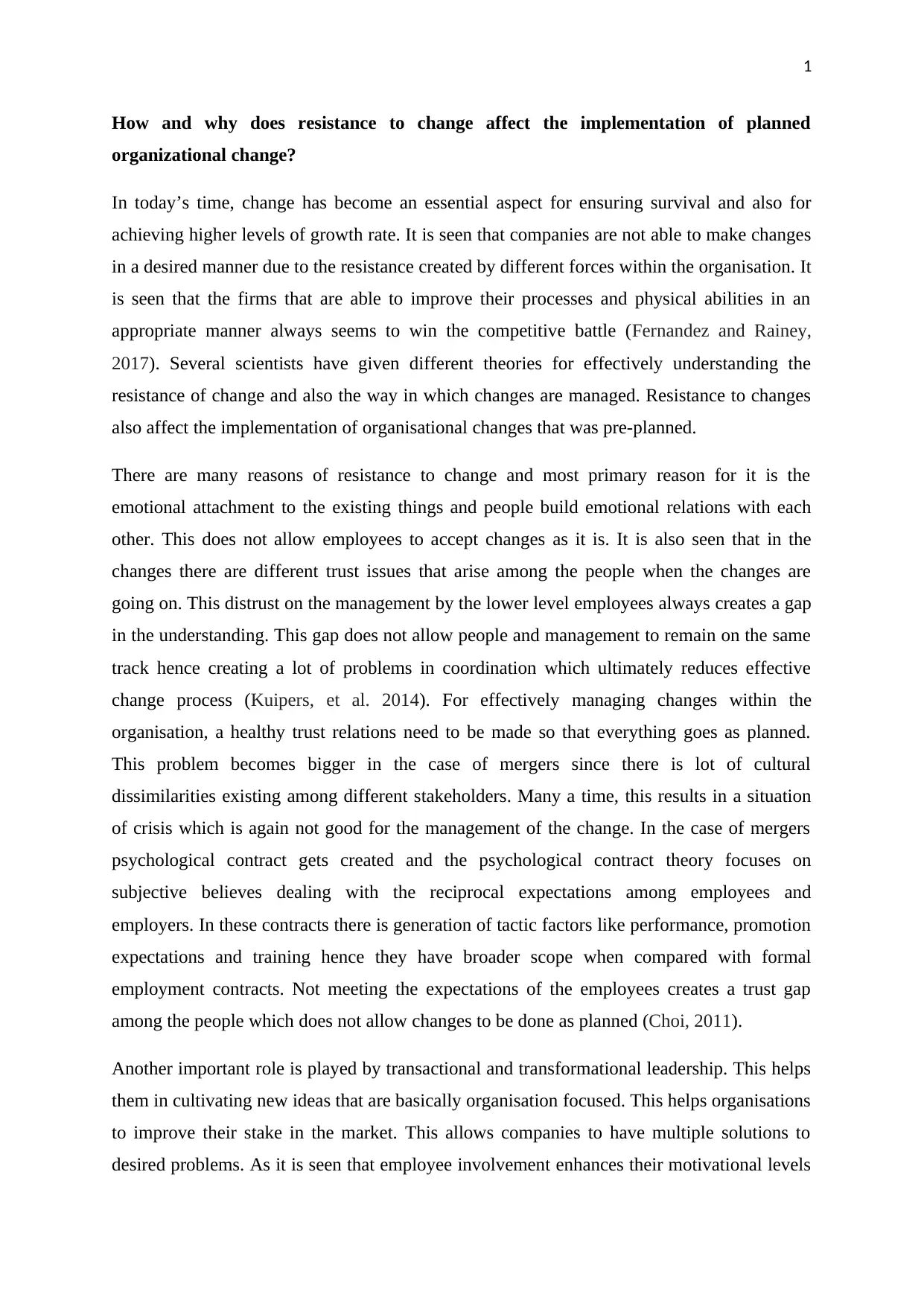
1
How and why does resistance to change affect the implementation of planned
organizational change?
In today’s time, change has become an essential aspect for ensuring survival and also for
achieving higher levels of growth rate. It is seen that companies are not able to make changes
in a desired manner due to the resistance created by different forces within the organisation. It
is seen that the firms that are able to improve their processes and physical abilities in an
appropriate manner always seems to win the competitive battle (Fernandez and Rainey,
2017). Several scientists have given different theories for effectively understanding the
resistance of change and also the way in which changes are managed. Resistance to changes
also affect the implementation of organisational changes that was pre-planned.
There are many reasons of resistance to change and most primary reason for it is the
emotional attachment to the existing things and people build emotional relations with each
other. This does not allow employees to accept changes as it is. It is also seen that in the
changes there are different trust issues that arise among the people when the changes are
going on. This distrust on the management by the lower level employees always creates a gap
in the understanding. This gap does not allow people and management to remain on the same
track hence creating a lot of problems in coordination which ultimately reduces effective
change process (Kuipers, et al. 2014). For effectively managing changes within the
organisation, a healthy trust relations need to be made so that everything goes as planned.
This problem becomes bigger in the case of mergers since there is lot of cultural
dissimilarities existing among different stakeholders. Many a time, this results in a situation
of crisis which is again not good for the management of the change. In the case of mergers
psychological contract gets created and the psychological contract theory focuses on
subjective believes dealing with the reciprocal expectations among employees and
employers. In these contracts there is generation of tactic factors like performance, promotion
expectations and training hence they have broader scope when compared with formal
employment contracts. Not meeting the expectations of the employees creates a trust gap
among the people which does not allow changes to be done as planned (Choi, 2011).
Another important role is played by transactional and transformational leadership. This helps
them in cultivating new ideas that are basically organisation focused. This helps organisations
to improve their stake in the market. This allows companies to have multiple solutions to
desired problems. As it is seen that employee involvement enhances their motivational levels
How and why does resistance to change affect the implementation of planned
organizational change?
In today’s time, change has become an essential aspect for ensuring survival and also for
achieving higher levels of growth rate. It is seen that companies are not able to make changes
in a desired manner due to the resistance created by different forces within the organisation. It
is seen that the firms that are able to improve their processes and physical abilities in an
appropriate manner always seems to win the competitive battle (Fernandez and Rainey,
2017). Several scientists have given different theories for effectively understanding the
resistance of change and also the way in which changes are managed. Resistance to changes
also affect the implementation of organisational changes that was pre-planned.
There are many reasons of resistance to change and most primary reason for it is the
emotional attachment to the existing things and people build emotional relations with each
other. This does not allow employees to accept changes as it is. It is also seen that in the
changes there are different trust issues that arise among the people when the changes are
going on. This distrust on the management by the lower level employees always creates a gap
in the understanding. This gap does not allow people and management to remain on the same
track hence creating a lot of problems in coordination which ultimately reduces effective
change process (Kuipers, et al. 2014). For effectively managing changes within the
organisation, a healthy trust relations need to be made so that everything goes as planned.
This problem becomes bigger in the case of mergers since there is lot of cultural
dissimilarities existing among different stakeholders. Many a time, this results in a situation
of crisis which is again not good for the management of the change. In the case of mergers
psychological contract gets created and the psychological contract theory focuses on
subjective believes dealing with the reciprocal expectations among employees and
employers. In these contracts there is generation of tactic factors like performance, promotion
expectations and training hence they have broader scope when compared with formal
employment contracts. Not meeting the expectations of the employees creates a trust gap
among the people which does not allow changes to be done as planned (Choi, 2011).
Another important role is played by transactional and transformational leadership. This helps
them in cultivating new ideas that are basically organisation focused. This helps organisations
to improve their stake in the market. This allows companies to have multiple solutions to
desired problems. As it is seen that employee involvement enhances their motivational levels
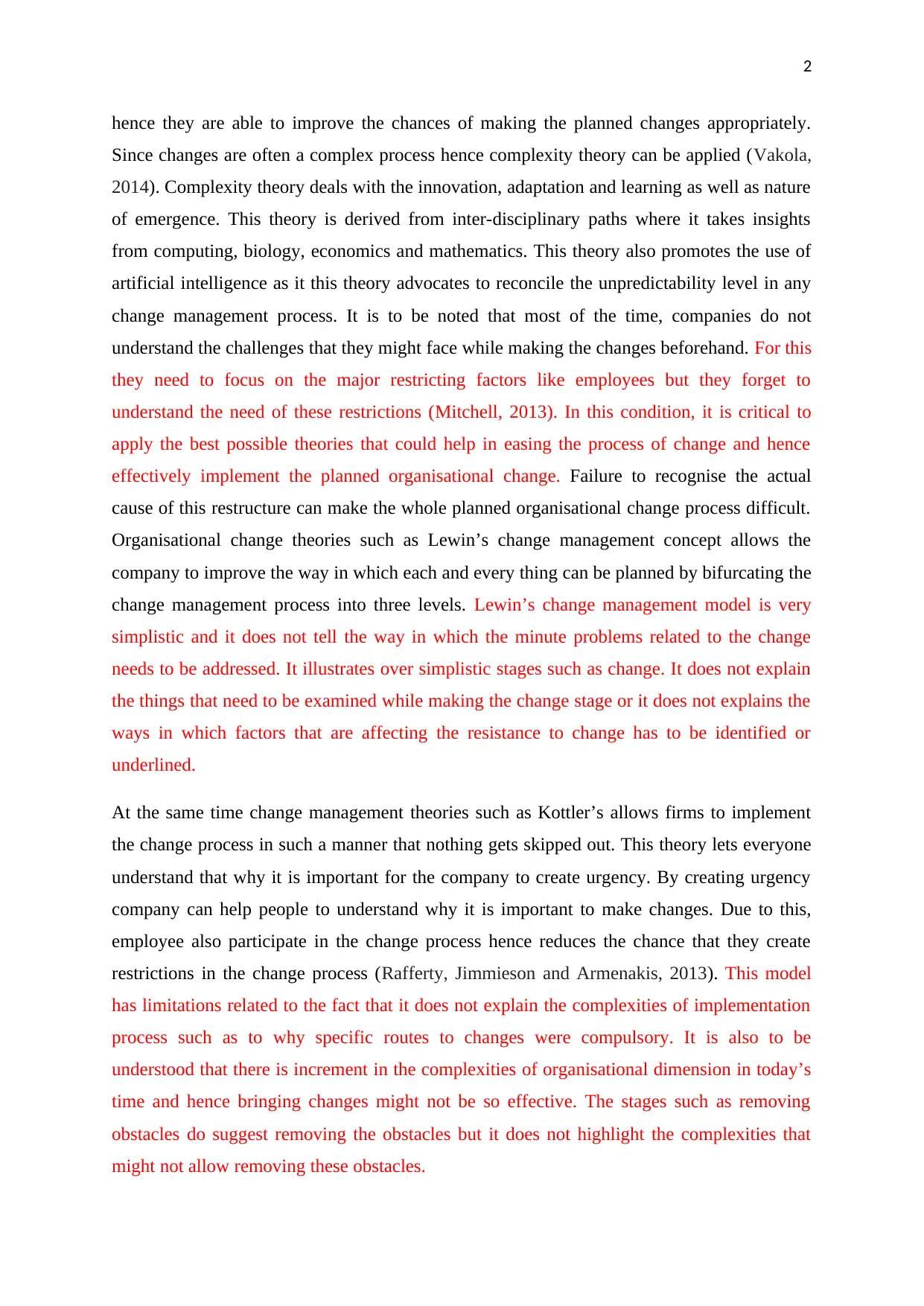
2
hence they are able to improve the chances of making the planned changes appropriately.
Since changes are often a complex process hence complexity theory can be applied (Vakola,
2014). Complexity theory deals with the innovation, adaptation and learning as well as nature
of emergence. This theory is derived from inter-disciplinary paths where it takes insights
from computing, biology, economics and mathematics. This theory also promotes the use of
artificial intelligence as it this theory advocates to reconcile the unpredictability level in any
change management process. It is to be noted that most of the time, companies do not
understand the challenges that they might face while making the changes beforehand. For this
they need to focus on the major restricting factors like employees but they forget to
understand the need of these restrictions (Mitchell, 2013). In this condition, it is critical to
apply the best possible theories that could help in easing the process of change and hence
effectively implement the planned organisational change. Failure to recognise the actual
cause of this restructure can make the whole planned organisational change process difficult.
Organisational change theories such as Lewin’s change management concept allows the
company to improve the way in which each and every thing can be planned by bifurcating the
change management process into three levels. Lewin’s change management model is very
simplistic and it does not tell the way in which the minute problems related to the change
needs to be addressed. It illustrates over simplistic stages such as change. It does not explain
the things that need to be examined while making the change stage or it does not explains the
ways in which factors that are affecting the resistance to change has to be identified or
underlined.
At the same time change management theories such as Kottler’s allows firms to implement
the change process in such a manner that nothing gets skipped out. This theory lets everyone
understand that why it is important for the company to create urgency. By creating urgency
company can help people to understand why it is important to make changes. Due to this,
employee also participate in the change process hence reduces the chance that they create
restrictions in the change process (Rafferty, Jimmieson and Armenakis, 2013). This model
has limitations related to the fact that it does not explain the complexities of implementation
process such as to why specific routes to changes were compulsory. It is also to be
understood that there is increment in the complexities of organisational dimension in today’s
time and hence bringing changes might not be so effective. The stages such as removing
obstacles do suggest removing the obstacles but it does not highlight the complexities that
might not allow removing these obstacles.
hence they are able to improve the chances of making the planned changes appropriately.
Since changes are often a complex process hence complexity theory can be applied (Vakola,
2014). Complexity theory deals with the innovation, adaptation and learning as well as nature
of emergence. This theory is derived from inter-disciplinary paths where it takes insights
from computing, biology, economics and mathematics. This theory also promotes the use of
artificial intelligence as it this theory advocates to reconcile the unpredictability level in any
change management process. It is to be noted that most of the time, companies do not
understand the challenges that they might face while making the changes beforehand. For this
they need to focus on the major restricting factors like employees but they forget to
understand the need of these restrictions (Mitchell, 2013). In this condition, it is critical to
apply the best possible theories that could help in easing the process of change and hence
effectively implement the planned organisational change. Failure to recognise the actual
cause of this restructure can make the whole planned organisational change process difficult.
Organisational change theories such as Lewin’s change management concept allows the
company to improve the way in which each and every thing can be planned by bifurcating the
change management process into three levels. Lewin’s change management model is very
simplistic and it does not tell the way in which the minute problems related to the change
needs to be addressed. It illustrates over simplistic stages such as change. It does not explain
the things that need to be examined while making the change stage or it does not explains the
ways in which factors that are affecting the resistance to change has to be identified or
underlined.
At the same time change management theories such as Kottler’s allows firms to implement
the change process in such a manner that nothing gets skipped out. This theory lets everyone
understand that why it is important for the company to create urgency. By creating urgency
company can help people to understand why it is important to make changes. Due to this,
employee also participate in the change process hence reduces the chance that they create
restrictions in the change process (Rafferty, Jimmieson and Armenakis, 2013). This model
has limitations related to the fact that it does not explain the complexities of implementation
process such as to why specific routes to changes were compulsory. It is also to be
understood that there is increment in the complexities of organisational dimension in today’s
time and hence bringing changes might not be so effective. The stages such as removing
obstacles do suggest removing the obstacles but it does not highlight the complexities that
might not allow removing these obstacles.
⊘ This is a preview!⊘
Do you want full access?
Subscribe today to unlock all pages.

Trusted by 1+ million students worldwide
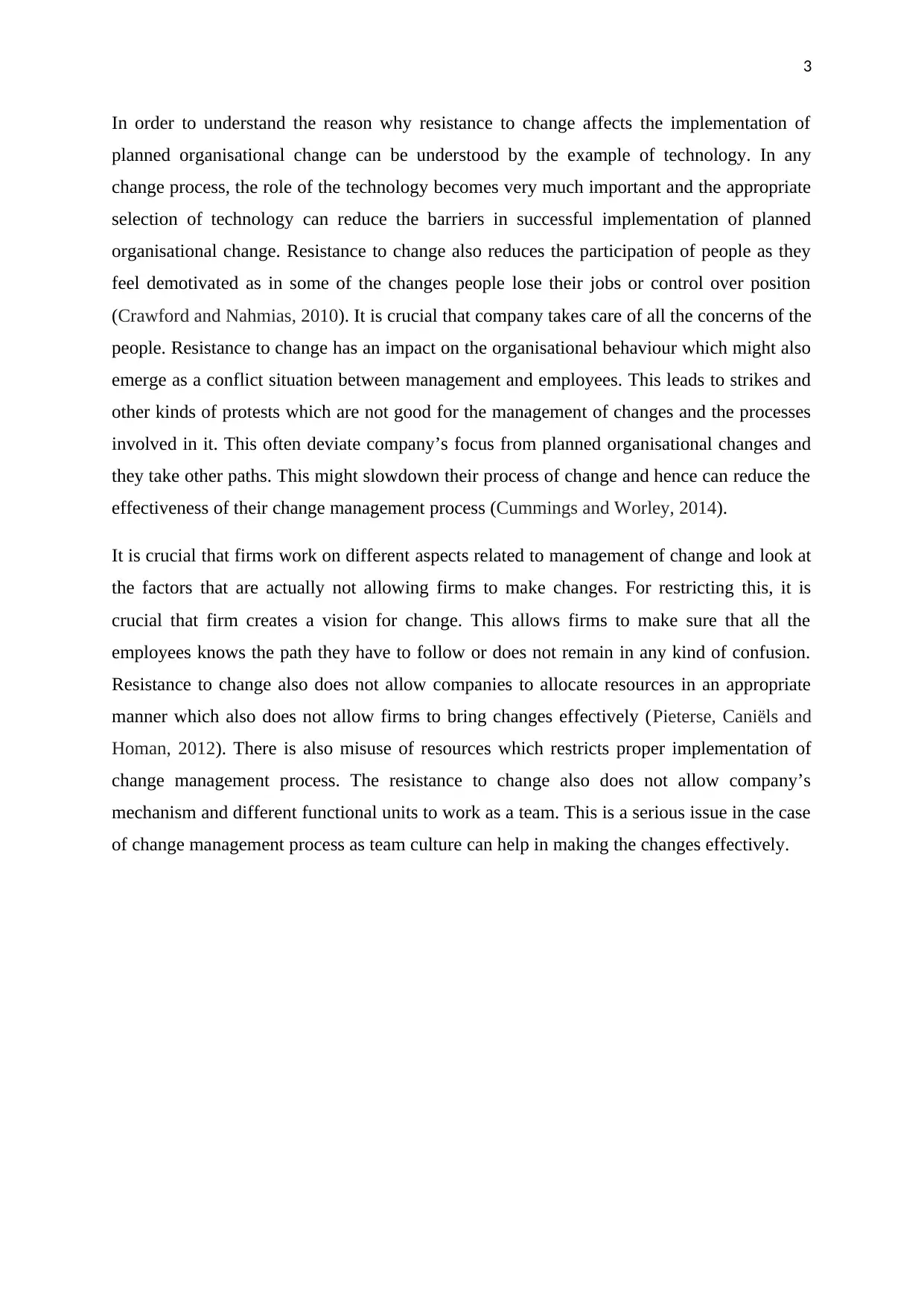
3
In order to understand the reason why resistance to change affects the implementation of
planned organisational change can be understood by the example of technology. In any
change process, the role of the technology becomes very much important and the appropriate
selection of technology can reduce the barriers in successful implementation of planned
organisational change. Resistance to change also reduces the participation of people as they
feel demotivated as in some of the changes people lose their jobs or control over position
(Crawford and Nahmias, 2010). It is crucial that company takes care of all the concerns of the
people. Resistance to change has an impact on the organisational behaviour which might also
emerge as a conflict situation between management and employees. This leads to strikes and
other kinds of protests which are not good for the management of changes and the processes
involved in it. This often deviate company’s focus from planned organisational changes and
they take other paths. This might slowdown their process of change and hence can reduce the
effectiveness of their change management process (Cummings and Worley, 2014).
It is crucial that firms work on different aspects related to management of change and look at
the factors that are actually not allowing firms to make changes. For restricting this, it is
crucial that firm creates a vision for change. This allows firms to make sure that all the
employees knows the path they have to follow or does not remain in any kind of confusion.
Resistance to change also does not allow companies to allocate resources in an appropriate
manner which also does not allow firms to bring changes effectively (Pieterse, Caniëls and
Homan, 2012). There is also misuse of resources which restricts proper implementation of
change management process. The resistance to change also does not allow company’s
mechanism and different functional units to work as a team. This is a serious issue in the case
of change management process as team culture can help in making the changes effectively.
In order to understand the reason why resistance to change affects the implementation of
planned organisational change can be understood by the example of technology. In any
change process, the role of the technology becomes very much important and the appropriate
selection of technology can reduce the barriers in successful implementation of planned
organisational change. Resistance to change also reduces the participation of people as they
feel demotivated as in some of the changes people lose their jobs or control over position
(Crawford and Nahmias, 2010). It is crucial that company takes care of all the concerns of the
people. Resistance to change has an impact on the organisational behaviour which might also
emerge as a conflict situation between management and employees. This leads to strikes and
other kinds of protests which are not good for the management of changes and the processes
involved in it. This often deviate company’s focus from planned organisational changes and
they take other paths. This might slowdown their process of change and hence can reduce the
effectiveness of their change management process (Cummings and Worley, 2014).
It is crucial that firms work on different aspects related to management of change and look at
the factors that are actually not allowing firms to make changes. For restricting this, it is
crucial that firm creates a vision for change. This allows firms to make sure that all the
employees knows the path they have to follow or does not remain in any kind of confusion.
Resistance to change also does not allow companies to allocate resources in an appropriate
manner which also does not allow firms to bring changes effectively (Pieterse, Caniëls and
Homan, 2012). There is also misuse of resources which restricts proper implementation of
change management process. The resistance to change also does not allow company’s
mechanism and different functional units to work as a team. This is a serious issue in the case
of change management process as team culture can help in making the changes effectively.
Paraphrase This Document
Need a fresh take? Get an instant paraphrase of this document with our AI Paraphraser
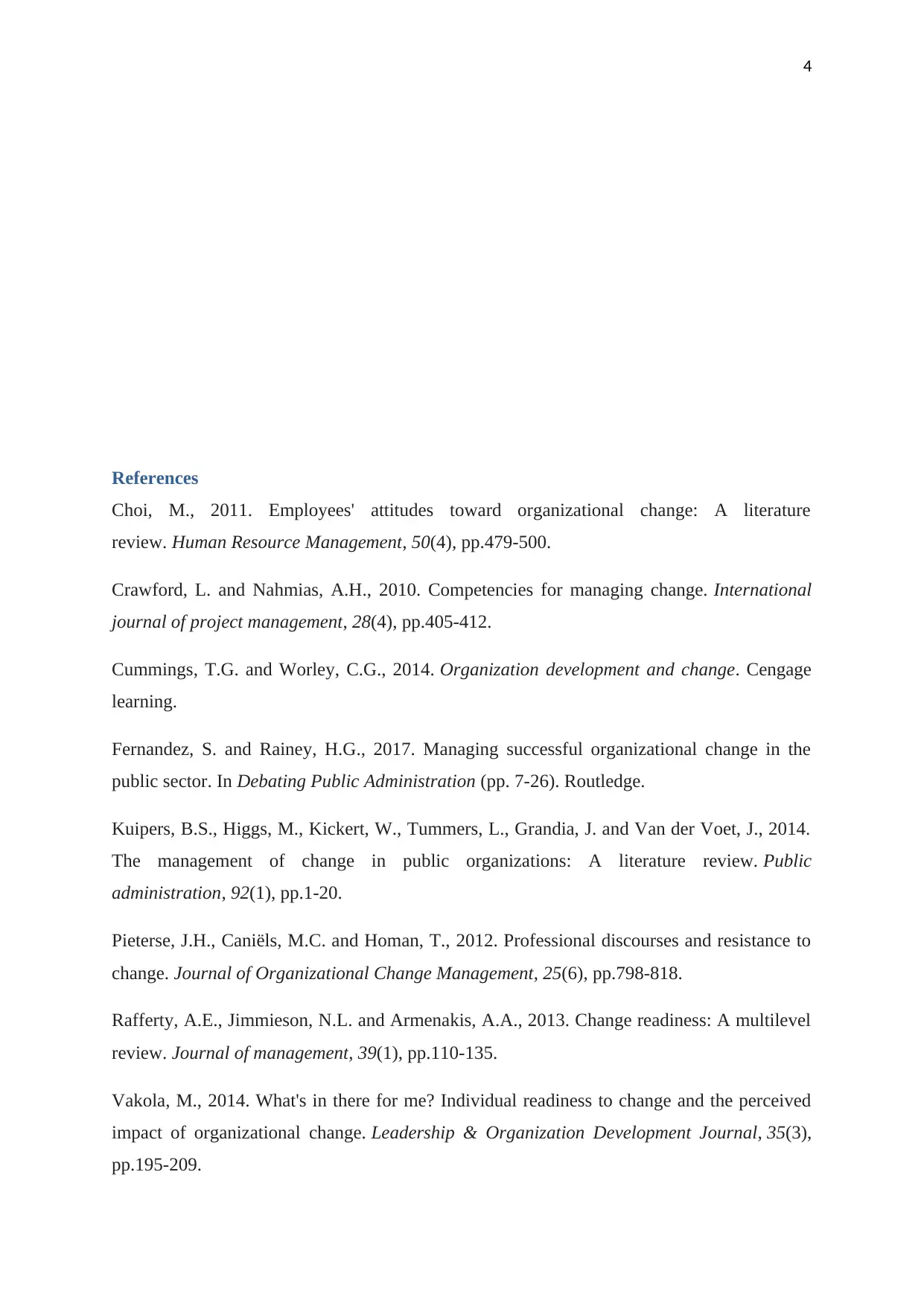
4
References
Choi, M., 2011. Employees' attitudes toward organizational change: A literature
review. Human Resource Management, 50(4), pp.479-500.
Crawford, L. and Nahmias, A.H., 2010. Competencies for managing change. International
journal of project management, 28(4), pp.405-412.
Cummings, T.G. and Worley, C.G., 2014. Organization development and change. Cengage
learning.
Fernandez, S. and Rainey, H.G., 2017. Managing successful organizational change in the
public sector. In Debating Public Administration (pp. 7-26). Routledge.
Kuipers, B.S., Higgs, M., Kickert, W., Tummers, L., Grandia, J. and Van der Voet, J., 2014.
The management of change in public organizations: A literature review. Public
administration, 92(1), pp.1-20.
Pieterse, J.H., Caniëls, M.C. and Homan, T., 2012. Professional discourses and resistance to
change. Journal of Organizational Change Management, 25(6), pp.798-818.
Rafferty, A.E., Jimmieson, N.L. and Armenakis, A.A., 2013. Change readiness: A multilevel
review. Journal of management, 39(1), pp.110-135.
Vakola, M., 2014. What's in there for me? Individual readiness to change and the perceived
impact of organizational change. Leadership & Organization Development Journal, 35(3),
pp.195-209.
References
Choi, M., 2011. Employees' attitudes toward organizational change: A literature
review. Human Resource Management, 50(4), pp.479-500.
Crawford, L. and Nahmias, A.H., 2010. Competencies for managing change. International
journal of project management, 28(4), pp.405-412.
Cummings, T.G. and Worley, C.G., 2014. Organization development and change. Cengage
learning.
Fernandez, S. and Rainey, H.G., 2017. Managing successful organizational change in the
public sector. In Debating Public Administration (pp. 7-26). Routledge.
Kuipers, B.S., Higgs, M., Kickert, W., Tummers, L., Grandia, J. and Van der Voet, J., 2014.
The management of change in public organizations: A literature review. Public
administration, 92(1), pp.1-20.
Pieterse, J.H., Caniëls, M.C. and Homan, T., 2012. Professional discourses and resistance to
change. Journal of Organizational Change Management, 25(6), pp.798-818.
Rafferty, A.E., Jimmieson, N.L. and Armenakis, A.A., 2013. Change readiness: A multilevel
review. Journal of management, 39(1), pp.110-135.
Vakola, M., 2014. What's in there for me? Individual readiness to change and the perceived
impact of organizational change. Leadership & Organization Development Journal, 35(3),
pp.195-209.
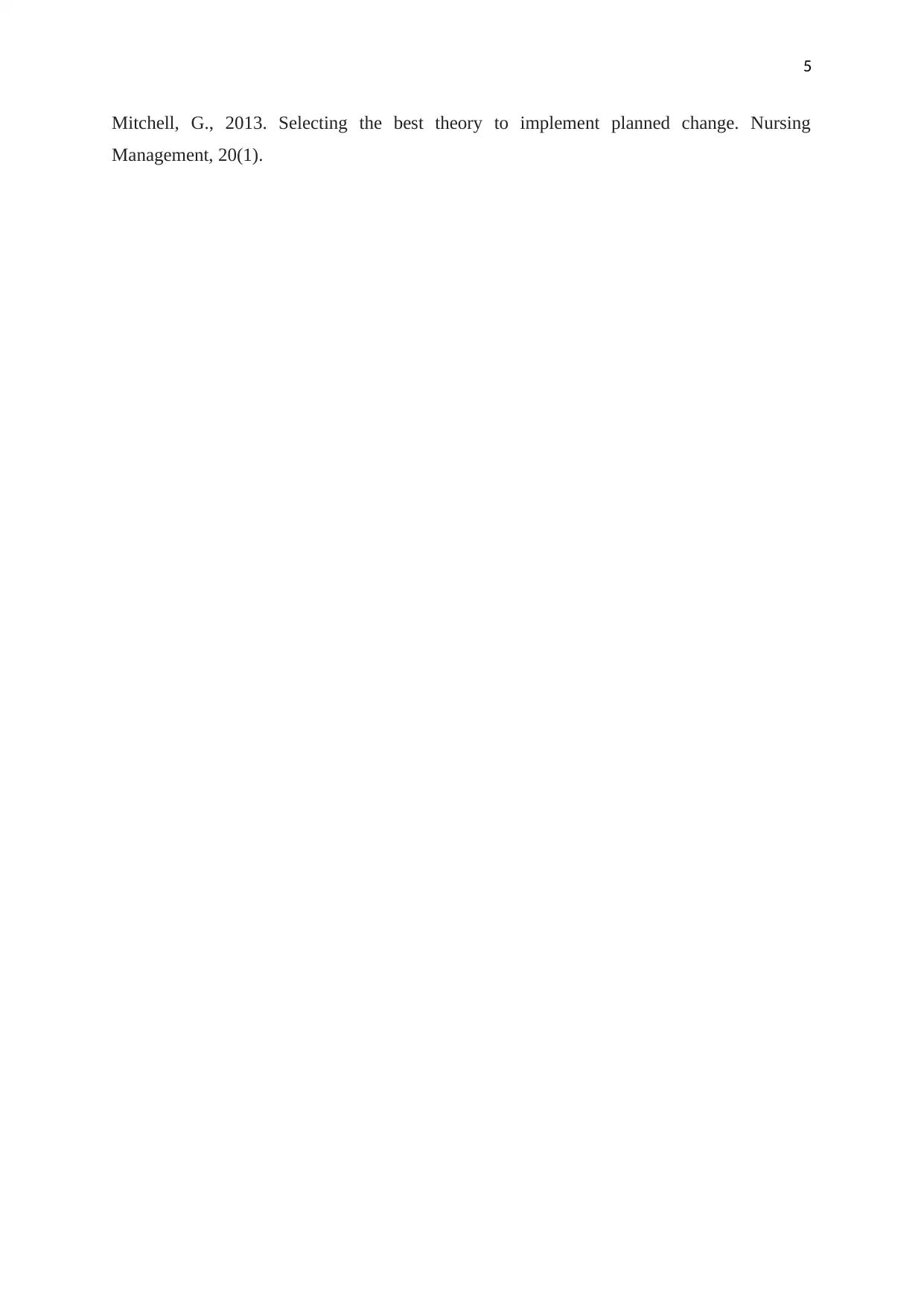
5
Mitchell, G., 2013. Selecting the best theory to implement planned change. Nursing
Management, 20(1).
Mitchell, G., 2013. Selecting the best theory to implement planned change. Nursing
Management, 20(1).
⊘ This is a preview!⊘
Do you want full access?
Subscribe today to unlock all pages.

Trusted by 1+ million students worldwide
1 out of 6
Related Documents
Your All-in-One AI-Powered Toolkit for Academic Success.
+13062052269
info@desklib.com
Available 24*7 on WhatsApp / Email
![[object Object]](/_next/static/media/star-bottom.7253800d.svg)
Unlock your academic potential
Copyright © 2020–2025 A2Z Services. All Rights Reserved. Developed and managed by ZUCOL.




